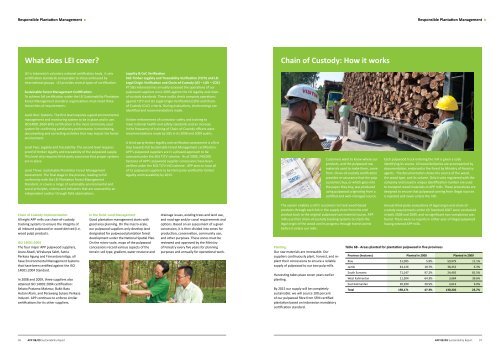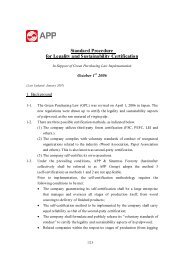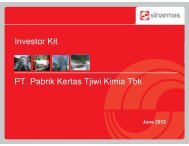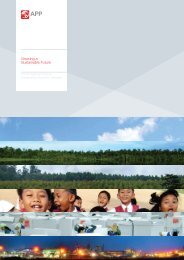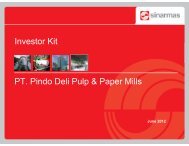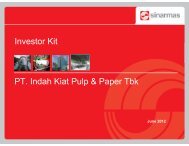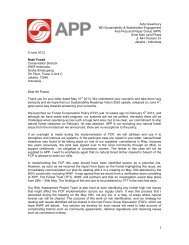APP Sustainability Report 2008-2009 - Asia Pulp and Paper
APP Sustainability Report 2008-2009 - Asia Pulp and Paper
APP Sustainability Report 2008-2009 - Asia Pulp and Paper
You also want an ePaper? Increase the reach of your titles
YUMPU automatically turns print PDFs into web optimized ePapers that Google loves.
Responsible Plantation Management<br />
Responsible Plantation Management<br />
What does LEI cover?<br />
Chain of Custody: How it works<br />
LEI is Indonesia’s voluntary national certification body. It sets<br />
certification st<strong>and</strong>ards comparable to those embraced by<br />
international groups. LEI provides several types of certification:<br />
Sustainable Forest Management Certification:<br />
To achieve full certification under the LEI <strong>Sustainability</strong> Plantation<br />
Forest Management st<strong>and</strong>ard, organizations must meet three<br />
hierarchies of requirements:<br />
Level One: Systems. The first level requires a good environmental<br />
management <strong>and</strong> monitoring system to be in place <strong>and</strong> in use.<br />
ISO14001:2004 EMS certification is the most commonly used<br />
system for confirming satisfactory performance in monitoring,<br />
documenting <strong>and</strong> correcting activities that may impact the forest<br />
environment.<br />
Level Two: Legality <strong>and</strong> Traceability. The second level requires<br />
proof of timber legality <strong>and</strong> traceability of the pulpwood supply.<br />
This level also requires third-party assurance that proper systems<br />
are in place.<br />
Level Three: Sustainable Plantation Forest Management<br />
Assessment. The final stage in the process, leading to full<br />
conformity with the LEI Plantation Forest Management<br />
St<strong>and</strong>ard., it covers a range of sustainable environmental <strong>and</strong><br />
social principles, criteria <strong>and</strong> indicators that are assessed by an<br />
independent auditor through field observations.<br />
Legality & CoC Verification<br />
SGS Timber Legality <strong>and</strong> Traceability Verification (TLTV) <strong>and</strong> LEI<br />
Legal Origin Verification <strong>and</strong> Chain-of-Custody (LEI – LOV – COC)<br />
PT SGS Indonesia has annually assessed the operations of our<br />
pulpwood suppliers since 2005 against the LEI legality <strong>and</strong> chainof-custody<br />
st<strong>and</strong>ards. These audits check company operations<br />
against TLTV <strong>and</strong> LEI Legal-Origin-Verification (LOV) <strong>and</strong> Chainof-Custody<br />
(CoC) criteria. During evaluations, shortcomings are<br />
identified <strong>and</strong> recommendations made.<br />
Stricter enforcement of contractor safety <strong>and</strong> training to<br />
meet national health-<strong>and</strong>-safety st<strong>and</strong>ards <strong>and</strong> an increase<br />
in the frequency of training of Chain-of-Custody officers were<br />
recommendations made by SGS in its <strong>2008</strong> <strong>and</strong> <strong>2009</strong> audits.<br />
A third-party timber legality <strong>and</strong> verification assessment is a first<br />
step towards full Sustainable Forest Management certification.<br />
<strong>APP</strong>’s pulpwood suppliers are in a phased approach to be<br />
assessed under the SGS TLTV scheme. As of <strong>2009</strong>, 240,000<br />
hectares of <strong>APP</strong>’s pulpwood supplier concessions have been<br />
verified under the SGS TLTV-VLO scheme. <strong>APP</strong> aims to have all<br />
of its pulpwood suppliers to be third party verified for timber<br />
legality <strong>and</strong> traceability by 2015.<br />
Customers want to know where our<br />
products, <strong>and</strong> the pulpwood raw<br />
materials used to make them, come<br />
from. Chain-of-custody certification<br />
provides re-assurance that the pulp<br />
customers buy, or which goes into<br />
the paper they buy, was produced<br />
using pulpwood originating from a<br />
certified <strong>and</strong> well-managed source.<br />
Each pulpwood truck entering the mill is given a code<br />
identifying its source. All wood deliveries are accompanied by<br />
documentation, endorsed in the forest by Ministry of Forestry<br />
agents. The documentation shows the source of the wood,<br />
the wood type, <strong>and</strong> its volume. Only trucks registered with the<br />
company <strong>and</strong> issued a unique identification number are used<br />
to transport wood materials to <strong>APP</strong> mills. These procedures are<br />
designed to ensure that pulpwood coming from illegal sources<br />
is rejected <strong>and</strong> never enters the mill.<br />
Chain of Custody Implementation<br />
All eight <strong>APP</strong> mills use chain-of-custody<br />
tracking systems to ensure the integrity of<br />
all inbound pulpwood or wood-derived (i.e.<br />
wood pulp) products.<br />
ISO 14001:2004<br />
The four major <strong>APP</strong> pulpwood suppliers,<br />
Arara Abadi, Wirakarya Sakti, Satria<br />
Perkasa Agung <strong>and</strong> Finnantara Intiga, all<br />
have Environmental Management Systems<br />
that have been certified against the ISO<br />
14001:2004 St<strong>and</strong>ard.<br />
In <strong>2008</strong> <strong>and</strong> <strong>2009</strong>, three suppliers also<br />
attained ISO 14001:2004 certification:<br />
Sekato Pratama Makmur, Bukit Batu<br />
Hutani Alam, <strong>and</strong> Perawang Sukses Perkasa<br />
Industri. <strong>APP</strong> continues to enforce similar<br />
certifications for its other suppliers.<br />
In the Field: L<strong>and</strong> Management<br />
Good plantation management starts with<br />
good area planning. On the macro-scale,<br />
our pulpwood suppliers only develop l<strong>and</strong><br />
designated for pulpwood plantation forest<br />
development under the National Spatial Plan.<br />
On the micro-scale, maps of the pulpwood<br />
concessions record various aspects of the<br />
terrain: soil type, gradient, water resource <strong>and</strong><br />
drainage issues, existing trees <strong>and</strong> l<strong>and</strong> use,<br />
<strong>and</strong> road-age <strong>and</strong>/or canal requirements <strong>and</strong><br />
options. Based on an assessment of a given<br />
concession, it is then divided into zones for<br />
production, conservation, community use,<br />
<strong>and</strong> other purposes. These zones must be<br />
reviewed <strong>and</strong> approved by the Ministry<br />
of Forestry every five years for planning<br />
purposes <strong>and</strong> annually for operational work.<br />
The system enables a mill’s customers to track wood-based<br />
products through each link in the supply chain from the end<br />
product back to the original pulpwood raw material source. <strong>APP</strong><br />
mills use their chain-of-custody tracking systems to check the<br />
legal origin of the wood <strong>and</strong> its progress through transit points<br />
before it enters our mills.<br />
Planting<br />
Our raw materials are renewable. Our<br />
suppliers continuously plant, harvest, <strong>and</strong> replant<br />
their concessions to ensure a reliable<br />
supply of pulpwood to our two pulp mills.<br />
Harvesting takes place seven years earlier<br />
planting.<br />
By 2015 our supply will be completely<br />
sustainable: we will source 100 percent<br />
of our pulpwood fibre from SFM certified<br />
plantation based on Indonesian m<strong>and</strong>atory<br />
certification st<strong>and</strong>ard.<br />
Annual third-party evaluations of legal origin <strong>and</strong> chain-ofcustody<br />
requirements under LEI St<strong>and</strong>ard 2007 were conducted<br />
in both <strong>2008</strong> <strong>and</strong> <strong>2009</strong>, <strong>and</strong> no significant non-compliance was<br />
found. There were no reports in either year of illegal pulpwood<br />
having entered <strong>APP</strong> mills.<br />
Table 68 - Areas planted for plantation pulpwood in five provinces<br />
Province (hectares) Planted in <strong>2008</strong> Planted in <strong>2009</strong><br />
Riau 51,095 5.9% 59,979 11.1%<br />
Jambi 44,126 18.7% 38,452 6.3%<br />
South Sumatra 71,147 97.2% 24,492 81.5%<br />
West Kalimantan 11,504 64.3% 3,684 39.6%<br />
East Kalimantan 20,299 29.5% 3,613 9.9%<br />
Total 198,171 47.3% 130,220 23.7%<br />
96 <strong>APP</strong> 08/09 <strong>Sustainability</strong> <strong>Report</strong> <strong>APP</strong> 08/09 <strong>Sustainability</strong> <strong>Report</strong> 97


